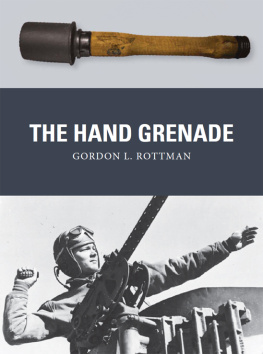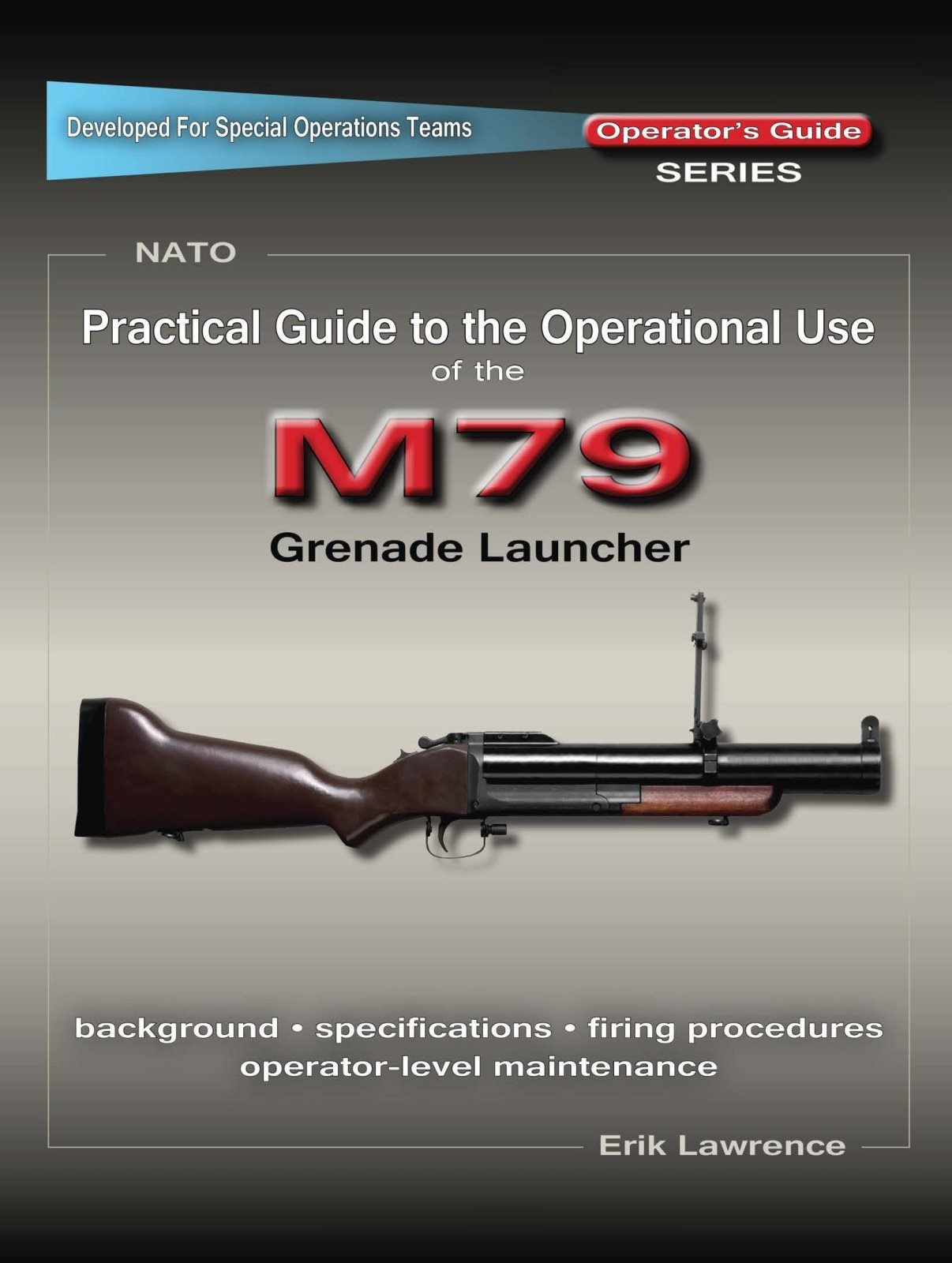Section 1
Introduction
The objective of this manual is to allow the reader to be able to use the M79 Grenade Launcher competently. The manual will give the reader background/specifications of the weapon; instructions on its operation, disassembly and assembly; proper firing procedure; and malfunction/misfire procedures. Operator-level maintenance will also be detailed to allow the reader to understand and become competent in the use and maintenance of the M79 Grenade Launcher.
Description

Figure 1-1 M79 Grenade Launcher
The M79 Grenade Launcher is a single-shot, break-open, breech-loading, shoulder-fired weapon (Figure 1-1). It consists of a receiver group, fore-end assembly, barrel group, sight assembly, stock assembly, and sling. A rubber recoil pad is attached to the butt of the stock to absorb some of the recoil. The M79 Grenade Launcher was designed to fire a 40mm grenade more accurately than when fired from a rifle grenade launcher.
The M79 was a standard single-shot, squad-support weapon that made its initial appearance with American troops during the Vietnam War. The system could lob a grenade projectile several hundred meters away and stop light-armored vehicles or flush out enemy elements from dug-in or elevated positions.
The M79 has been in service with the US Army and Marine Corps since 1961, and it is in service with many other militaries. It is currently being superseded in US service by the M203.
The secret to the success of the M79 was a high-low pressure system that allowed the propellant to develop a relatively high pressure in a high-pressure chamber before venting gases into a low-pressure chamber in the grenade cartridge case.
The M79 was the first weapon to come into service which was specifically designed to fire spin-stabilized grenades. It is a light weapon with acceptable recoil and an adequate range. A trained man can fire a grenade with great precision up to 150 m range.
The M79 was designed to launch a variety of ammunition types, including HE, flechette, buckshot, smoke, and non-lethal rounds. The system itself was very simplistic featuring a breech-loading component with static iron sights (the user would load the weapon by folding the barrel portion forward, similar to what is done to load some shotgun types). A folding ladder sight was also prominently integrated for elevated-range firing. The single-shot capability proved to be a major drawback as the user was unable to keep up any well-respected rate of fire on enemy positions for suppression purposes.
The characteristics of the M79 grenade Launcher:
A. Country of Origin: USA
B. Military Designation: M79
C. Weight
a. Unloaded - 6 pounds (2.72 kg)
b. Loaded - 6.5 pounds (2.95 kg)
D. Length
a. Launcher (overall) - 29 inches (73.7 cm)
b. Barrel group - 15 inches (38.1 cm)
c. Barrel only - 14 inches (35.6 cm)
E. Cartridge Type: 40x46mm low-velocity grenade cartridge
F. Muzzle Velocity: 76 meters per second (250 fps)
G. Type of Feed: Single-shot
H. Action: Breech-loaded, break-open
I. Chamber Pressure: 17,685 kilopascals (3,000 PSI)
J. Sights:
a. Front- Blade-type
b. Folding leaf-type, adjustable
K. Maximum Range: 400 meters (1,312 feet)
L. Maximum Effective Range:
a. Area target - 350 meters (1,148 feet)
b. Point target - 150 meters (492 feet)
M. Minimum Safe Firing Range:
a. Training - 130 meters (426 feet)
b. Combat - 31 meters (102 feet)
Background
Grenade launchers were delivered to the US Army. They were designed as a close support weapon for the infantry in order to bridge the gap in range between hand-thrown grenades and mortars (between 50 and 300 meters). This unique ability gave the squad a very lethal, integral indirect-fire weapon.
The M79 was a product of the failure of Project NIBLICK to create an envisioned multi-shot 40mm system for which the cartridge had originally been designed. In many respects a crude system, the M79 nevertheless provided an excellent force multiplier until the arrival of the first generation of under barrel grenade launchers (UGLs), the XM148 and the XM203. Commonly known as the "Thump-Gun," "Thumper," or "Blooper" in US service, it is also known to some Australian units as the "Wombat Gun." It closely resembles a large bore, break-action, sawn-off shotgun, and can fire a wide variety of 40mm rounds, including explosive, antipersonnel, smoke, buckshot, flechette, and incendiary. During the 1960s and 70s, the US experimented with many types of grenade launchers attached to rifles, which allowed the grenadier to also function as a rifleman.
These weapons were developed because the M79's greatest drawback proved to be its single-shot-only capability. This left the user totally unable to keep up a constant volume of fire during a firefight, and often grenadiers were only equipped with a pistol as a backup, if even that.
Short in length and fairly light in weight, the M79 proved extremely useful in the confining jungles of Vietnam. The M79 grenade launcher may also be known as the "Bloop Tube", "Blooper," "Thumper," or "Thump-Gun." In its current form, the M79 is in limited use around the globe, some seeing police duty in the crowd-control role.
One of the few completely new infantry weapons to appear during the Vietnam War, the M79 had no counterpart in the enemy's arsenal. It resembles a sawed-off shotgun and fires a spherical 40mm grenade which has a "kill radius" of five meters. Grooves in its barrel imparted a spiral spin to the warhead, stabilizing its flight. The spiral also caused weights in the fuse mechanism to arm the fuse after about 30 meters of flight, after which the shell detonated on impact. The grenades were thus safe from accidental detonation from a bump or fall, or if struck by a bullet.
Components
The major components of the 40-mm grenade launcher are shown in Figure 1-2. The front and rear sights, the safety, the trigger and trigger guard detent assembly, and the barrel-locking latch and lever are shown in Figures 1-3 through 1-8.

Figure 1-2 Relationship of components

A. Rear-Sight Assembly . Figure 1-3 shows the adjustable rear-sight assembly, which consists of a rear-sight lock, a windage screw and scale, an elevation scale and lock screw, a sight carrier and retainer locknut, an elevating screw wheel and elevating screw, and a rear-sight frame with fixed leaf sight. To align the rear sight with the front sight, adjust the ladder on the rear sight. The M79 had a large flip-up sight situated halfway down the barrel, with a basic leaf foresight fixed at the end of the barrel. The rear sight was calibrated up to 375 meters (410 yds) in 25 meter (27.3 yds) intervals. In the hands of a good experienced grenadier, the M79 was highly accurate up to 200 meters.

Figure 1-3 Rear sight

















